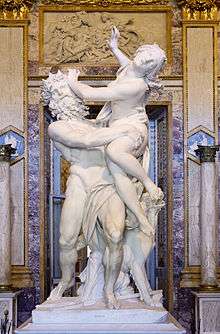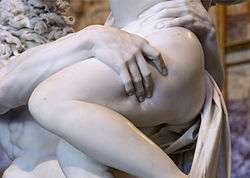The Rape of Proserpina
 | |
| Artist | Gian Lorenzo Bernini |
|---|---|
| Year | 1621–22 |
| Catalogue | 10 |
| Type | Sculpture |
| Medium | Marble |
| Dimensions | 225 cm (89 in) |
| Location | Galleria Borghese, Rome |
| Coordinates: 41°54′50.4″N 12°29′31.2″E / 41.914000°N 12.492000°E | |
The Rape of Proserpina is a large Baroque marble sculptural group by Italian artist Gian Lorenzo Bernini, executed between 1621 and 1622. Bernini was only 23 years old at its completion. It depicts the Abduction of Proserpina, where Proserpina is seized and taken to the underworld by the god Pluto.[1][2]

Patronage
As with many of Bernini's early works, it was commissioned by Cardinal Scipione Borghese, possibly alongside a portrait of Scipione's uncle Pope Paul V (who had died in 1621). Bernini received at least three payments for the statue, of value of at least 450 Roman scudi. The sculpture was begun in 1621 and completed in 1622. Quite soon after completion, the statue was given by Scipione to Cardinal Ludovisi in 1622, who transported it to his villa. Purchased by the Italian State, it returned to the Villa Borghese in 1908.[3]
Critical reaction
Most critics have also been quick to praise the work. Rudolf Wittkower noted that "representations of such rape scenes depended on Bernini's new, dynamic conception for the next hundred and fifty years".[4] Howard Hibbard makes similar comments noting the realistic effects that Bernini had achieved via the carving hard marble—such as the "texture of the skin, the flying ropes of hair, the tears of Persephone and above all the yielding flesh of the girl".[5] The choice of incident to depict the story is commonly cited as well—Pluto's hands encircle the waist of Proserpina just as she throws her arms out in an attempt to escape.[6] Bernini's own son and biographer, Domenico, called it "an amazing contrast of tenderness and cruelty".[7] However, in the eighteenth and nineteenth centuries, when Bernini's reputation was at a low ebb, critics found fault with the statue. The eighteenth-century French visitor Jerome de la Lande allegedly wrote that "Pluto's back is broken; his figure extravagant, without character, nobleness of expression, and its outline bad; the female one no better".[8] Another French visitor to the Villa Ludovisi was equally critical, stating, "The head of Pluto is vulgarly gay his crown and beard give him a ridiculous air, while the muscles are strongly marked and figures poses. It is not a true divinity, but a decorative god."[9]
Others have remarked on the twisted contrapposto or figura serpentinata pose of the group. While reminiscent of Mannerism, particularly Giambologna's The Rape of the Sabine Women, Bernini permits the viewer to absorb the scene from one single viewpoint. While other views provide further details, a spectator can see the desperation of Persephone and the lumbering attempts of Pluto to grab her. This was in contrast to the Mannerist sculpture of Giambologna, which required the spectator to walk around the sculpture to gain a view of each of character's expressions.[10][11]
Related works
- In 1811, the Russian sculptor Vasily Demut-Malinovsky created a sculpture also titled "The Abduction of Proserpina". The statue currently resides in Saint-Petersburg.
- Jeff Koons's "Pluto and Proserpina" is an 11-foot-tall stainless steel sculpture with transparent color coating and live flowering plants. Argentine developer and art collector Eduardo Costantini purchased it to place in the breezeway at his luxury oceanfront condo in Bal Harbour, Florida, which is slated for completion in 2016.[12]
- A copy by Georg Franz Ebenhech is in the park of Sanssouci in Potsdam, Germany
- A namesake of the work, the Rape of Proserpine ( 1818 ) by Francesco Andreoli, placed in the courtyard of the palazzo Sassi Masini in Forlì .
History
During the First World War, the sculpture was protected by a box and sandbags to protect it from damage.[13]
References
Citations
- ↑ Avery 1997, p. 49
- ↑ Wittkower 1955, p. 235.
- ↑ Wittkower 1955, p. 235.
- ↑ Wittkower 1955, p. 14.
- ↑ Hibbard 1990, p. 45.
- ↑ Hibbard 1990, p. 45.
- ↑ Bernini 2011, p. 18.
- ↑ Smith 2010, p. 238.
- ↑ Taine, 1871, p. 205.
- ↑ Hibbard 1990, p. 48.
- ↑ "Bernini's Pluto and Proserpina". Smart History. Retrieved January 5, 2013.
- ↑ Whelan, Robbie (25 September 2013). "Newest Miami Condo Enticement: Modern Art". Wall Street Journal.
- ↑ "Roma: Galleria Borghese, protezione del Ratto di Proserpina del Bernini". Europeana. Retrieved 2013-04-19.
Sources
- Avery, Charles (1997). Bernini: Genius of the Baroque. London: Thames and Hudson. ISBN 9780500286333.
- Baldinucci, Filippo (2006) [1682]. The Life of Bernini. University Park: Pennsylvania State University Press. ISBN 9780271730769.
- Bernini, Domenico (2011) [1713]. The Life of Giano Lorenzo Bernini. University Park: Pennsylvania State University Press. ISBN 9780271037486.
- Hawley, Henry (April 1971). "A Terra-Cotta Model for Bernini's Proserpina". The Bulletin of the Cleveland Museum of Art. 58: 107–111. JSTOR 25152371.
- Mormando, Franco (2011). Bernini: His Life and His Rome. Chicago: University of Chicago Press. ISBN 9780226538525.
- Smith, Sir James Edward (2010) [1793]. A Sketch of a Tour on the Continent. Nabu Press. ISBN 978-1145289536.
- Taine, Hippolyte (1871). Italy: Rome and Naples; Florence and Venice. Leypoldt & Holt.
- Wittkower, Rudolf (1955). Gian Lorenzo Bernini: The Sculptor of the Roman Baroque. London: Phaidon Press. ISBN 9780801414305.
External links
|
|
-
 Media related to The Rape of Proserpina at Wikimedia Commons
Media related to The Rape of Proserpina at Wikimedia Commons - Web Gallery of Art
- Galleria Borghese
- Vita del Cavalier Gio. Lorenzo Bernino at Google Books
- Vita del cavaliere Gio. Lorenzo Bernino at Google Books